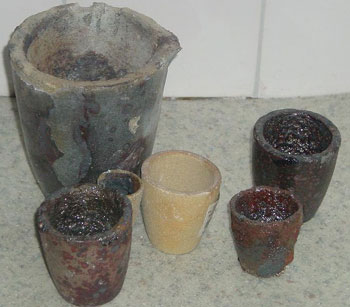Melt Precious Metals
Jewelers, refiners and buyers of precious metals are the most likely to melt precious metals, their reasons and methods can vary greatly. Jewelers may melt down a used or traded in piece to create a new ring or chain.
Small and large refiners often melt quantities of precious metals using Induction Melting Machines or furnaces. Smaller operations, usually home-based or hobbyists use oxygen and/or Mapps torches for their melting.
Precious metals are reclaimed or recycled and melted from a variety of sources like jewelry, coins, silverware, electronic or computer components, electrical contacts, medical devices, catalytic converters, to name a few.
Melting Points Of Precious Metals
| Gold | Silver | Platinum | Palladium | |
| Chemical Symbol | Au | Ag | Pt | Pd |
| Density (g/cm3) | 19.32 | 10.49 | 21.45 | 12.02 |
| Melting point (°C) | 1064°C | 961°C | 1,769°C | 1,554°C |
| Vickers hardness no.* | 40 | 40 | ||
| Electrical resistivity (microhm.cm at 0°C) |
9.85 | 9.93 | ||
| Thermal conductivity (watts/metre/°C) |
73 | 76 | ||
| Tensile strength* (kg/mm2) |
14 | 17 |
| Rhodium | Iridium | Ruthenium | Osmium | |
| Chemical Symbol | Rh | Ir | Ru | Os |
| Density (g/cm3) | 12.41 | 22.65 | 12.45 | 22.61 |
| Melting point (°C) | 1,960°C | 2,443°C | 2,310°C | 3,050°C |
| Vickers hardness no.* | 101 | 220 | 240 | 350 |
| Electrical resistivity (microhm.cm at 0°C) |
4.33 | 4.71 | 6.80 | 8.12 |
| Thermal conductivity (watts/metre/°C) |
150 | 148 | 105 | 87 |
| Tensile strength* (kg/mm2) |
71 | 112 | 165 | – |
Using Torches To Melt Precious Metals
When performing small to medium sized manufacturing ensure that open flame devices such as casting torches and ovens have adequate ventilation. Typically a bench jeweler will have a torch, usually a compressed oxygen tank, make sure it is chained or secured adequately to a sturdy wall.
When working with torches you need to ensure that all surrounding areas are fire resistant and needless to say make sure you have the proper fire extinguishers available incase of mishap. Safety must always be paramount.
There are a number of different gases you can use with your torch:
- Natural Gas -the gas that is supplied from your city/town. Usually a mixture of Methane and Ethane, this is probably the most commonly used by small to medium sized shops.
- Hydrogen – Thought to be the cleanest burning gas as well as a high heat gas, the best for platinum alloys.
- Propane – used when natural gas is not available, requires lots of oxygen to burn and ventilation recommended.
- Acetylene – Agreed to be a ‘dirty’ gas, it creates alot of carbon soot, creates alot of heat and is thought to be hard on your metals.
- All of the gases listed above require oxygen or compressed air.
It is said the most important factor when using a torch to melt is complete burning without having the torch overheat. If your torch is too hot or too cold you create unwanted compounds like carbons and copper oxides. Soot is the biggest culprit of poor combustion.
Crucibles
Crucibles are vessels used to melt and process materials at excessive temperatures. They are available in a variety of shapes and sizes, and are composed of materials that can withstand extremely high temperatures up to 1600°C.
Crucibles are usually made of graphite with clay as a binder. The crucible is placed in the furnace, after melting, the liquid metal is poured into a mold.
Furnaces Used To Melt Precious Metals
Resistance Melting
This is a electrical device that melts precious metals, usually by having a coiled wire surrounding a crucible, the wire is heated to a high temperature by passing electricity through the wire.
Induction Melting
This technology was once reserved for larger smelter but new developments have allowed small and medium sized shop access to the same technology. An induction smelter is a electrical device using high and/or medium frequency radio waves that generate enough heat within the crucible to melt precious metals.
Different frequencies produce different results, i.e. medium frequencies actually stir the molten metal which is a significant advantage.
Larger operations use much larger scale smelters and other methods of refining precious metals.
Note Of Caution:
I would advise the laymen to stay away from the exercise of melting your own metals. If you’re insistent on melting our own precious metals make sure you do plenty of research, arm yourself with the proper equipment and safety apparatus.
*Be warned that the fumes from various torch gases and metals can combine to damage your eyes, skin and respiratory system so my advice is don’t do it unless you have the proper equipment and training.*
We Buy Gold, Platinum And Silver In Any Condition Canada Wide.
If you’re thinking of selling your unwanted gold, platinum or silver remember we buy gold and precious metals Canada wide including:
Ontario On, British Columbia BC, Alberta AB, Saskatchewan SK, Manitoba MB, Quebec QC, Nova Scotia NS, New Brunswick NB, Newfoundland and Labrador NL, Prince Edward Island PEI, Yukon YT, Nunavut and the North West Territories NT
Click here to return to Resource Center from Melt Precious Metals page.










